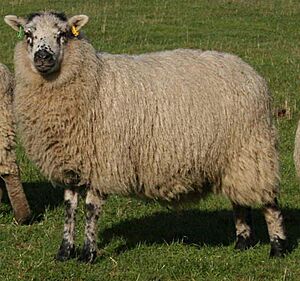Scottish Dunface facts for kids
The Scottish Dunface was an old type of sheep from Scotland. People also called it the Old Scottish Short-wool, Scottish Whiteface, or Scottish Tanface. It belonged to a group of sheep known for having short tails, common in northern Europe. The Dunface was likely very similar to the sheep that lived across the British Isles during the Iron Age.
By the mid-1800s, most Dunface sheep were replaced by other breeds, like the Scottish Blackface. The last Dunface sheep on mainland Scotland died out around the late 1800s. But some types of Dunface sheep survived on islands around Scotland. These island sheep helped create or are related to modern breeds you might know today, such as the Shetland, North Ronaldsay, Hebridean, and Boreray sheep.
Contents
What Did the Dunface Look Like?
The Scottish Dunface was a sheep with a short tail. It had soft, fine wool. Its face was often a brownish color. Their wool could be many different colors, including white, black, brown, or a dull brownish-gray color called "dun."
Most female Dunface sheep (called ewes) did not have horns. The male sheep (rams) usually had horns. However, some Dunface sheep from the Hebrides islands were different. In those groups, both males and females had horns. Sometimes, they even had two or more pairs of horns!
The History of the Dunface Sheep
Sheep living across the British Isles during the Iron Age were small. They had short tails and came in many different colors. Over time, starting around Roman times, these short-tailed sheep slowly began to be replaced. First, white-faced sheep with longer tails became more common. Later, long-tailed, black-faced sheep with horns took their place.
The short-tailed Iron Age sheep survived in the Scottish Highlands and Islands. Here, they were known as the Dunface. By the late 1700s, the Dunface was still the only type of sheep found in this area.
Why Did They Disappear?
During the next century, the Dunface sheep continued to be replaced. Two new long-tailed breeds, the Scottish Blackface and the Cheviot, became very popular. The very last group of Dunface sheep on mainland Scotland is thought to have died out near Inverness around 1880.
After this, the only Dunface sheep left were on faraway islands. These islands included St Kilda, Shetland, and Orkney. Some were also kept as pets in large parks.
Modern Sheep Related to the Dunface
The Dunface sheep helped create, or are related to, several modern sheep breeds:
- The Boreray sheep: These sheep come from the Dunface sheep kept on the St Kilda archipelago. In the late 1800s, they mixed a little with Scottish Blackface sheep. (It's important to know that the Soay sheep, another type on St Kilda, is even older and not from the Dunface.)
- The Hebridean sheep: Multi-horned Dunface sheep lived longest on the island of North Uist in the Hebrides. These were likely the basis for what became known as "St Kilda" sheep, now called Hebridean sheep. By the early 1900s, they were gone from the Hebrides. But they survived in parks in England and mainland Scotland.
- The North Ronaldsay sheep: This breed is a remaining group of Dunface sheep from Orkney.
- The Shetland sheep: These sheep are also descendants of the Dunface.
- The Castlemilk Moorit: This is another ornamental type of sheep. It partly comes from Shetland sheep.
The Dunface was similar to other short-tailed sheep found in the British Isles. These include the Manx Loaghtan from the Isle of Man. It also resembled the extinct Kerry Mountain and Cladagh sheep from western Ireland.
How Dunface Sheep Were Cared For
Dunface sheep were usually kept in small groups. During the day, a boy or girl would look after them. At night, the sheep were brought inside for safety. Their fine wool was very valuable to people.


